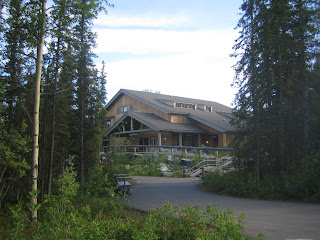Denali National Park covers about 6 million acres. It's about the size of Massachusetts, or half the size of Switzerland. If you could explore 1,000 acres per day, it would take you almost 16 1/2 YEARS to see the whole park. The Denali train station is right inside the park entrance, and only a couple hundred yards from the visitors center.

Denali train station
Visitors Center
Within all of Denali's 6 million acres, there are only about 275 established campsites in 7 different campgrounds. About 150 of the park's campsites are at Riley Creek.
Riley Creek, about 100 yds from my campsite
My campsite
Each campsite has a bear-proof food locker, and unless you're actually in the processs of cooking and/or eating, all of your stuff is supposed to remain in the locker. There's also a fire-pit, and you're allowed to pick up fallen wood around the campground. After seeing the sign in the picture below, I was a little concerned that my food locker was only about 30 feet from my tent. More alarming, though, was that as I was looking around for firewood, I found a huge pile of fresh anamal "skat" about 10 feet from my tent. Turns out that it came from a moose, however, and not a bear. For some reason, that made me feel better.
Sign between my campground and visitors center
Also close to the Riley Creek campground is the Wilderness Access Center, or "WAC", which is the trasportation hub of the park. Outside of this area immediately inside the main gate, there is only one 90-mile road that goes into the park. The rest is all wilderness, and there are no maintained trails. The first 15 miles of the road are paved, then it turns to gravel. At that point, there's a gate and a ranger station, and the road is no longer open to public traffic - to use it and go further into the park, you have be on a shuttle-bus from the WAC.
The smaller campgrounds are all located out along the park road at distances ranging from 13 miles to 85 miles from the entrance. Some of the sites can be reserved in advance while others are only available to "walk-ups". The two smallest campgrounds have only 7 campsites each, and no improvements, such as toilets or running water. Wilderness, or backcountry camping is also allowed, and I'll describe that a little later.




